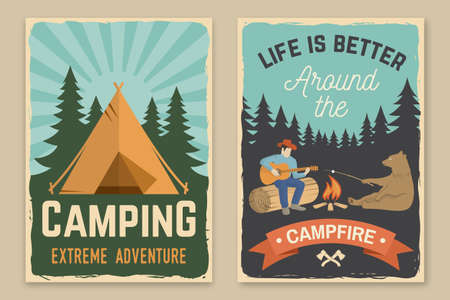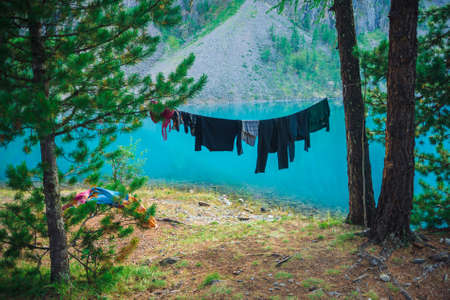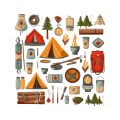1. Choosing a Sustainable Campsite Location
If youre new to eco-friendly camping, one of the first and most important steps is picking the right spot to set up your tent. Choosing a sustainable campsite location helps protect nature and keeps our favorite outdoor places beautiful for everyone to enjoy.
Follow Designated Trails and Campgrounds
Stick to marked trails and established campgrounds whenever possible. These areas are designed to handle foot traffic and camping activities without damaging the environment. Wandering off-trail can cause soil erosion, trample fragile plants, and disturb animal habitats.
Why Established Sites Matter
| Feature | Benefit |
|---|---|
| Marked Trails | Protects native vegetation and prevents soil compaction |
| Designated Campgrounds | Minimizes human impact on untouched areas |
| Provided Amenities (e.g., fire rings, toilets) | Reduces need for makeshift solutions that harm nature |
Respect Wildlife Habitats
Before setting up camp, take a moment to observe the area. Avoid camping near animal dens, nesting areas, or watering holes. These spots are crucial for local wildlife survival, and disturbing them can have long-term effects on the ecosystem.
Tips for Respecting Wildlife:
- Keep at least 200 feet away from lakes and streams to protect water sources.
- Avoid loud noises and bright lights that could scare animals.
- Never feed wild animals—it changes their natural behavior.
Use Leave No Trace Principles
The Leave No Trace principles offer easy-to-follow guidelines to help campers minimize their environmental footprint. Here’s how they apply when choosing your campsite:
| Principle | Campsite Application |
|---|---|
| Plan Ahead and Prepare | Research if the area allows camping; check local regulations. |
| Travel and Camp on Durable Surfaces | Select gravel, rock, or dry grass instead of soft soil or mossy ground. |
| Avoid Sensitive Areas | Stay away from alpine meadows, wetlands, and other fragile ecosystems. |
By thoughtfully selecting where you set up your eco-friendly campsite, youre already taking a big step toward responsible outdoor living. Keep these practices in mind every time you head out into nature!
2. Eco-Friendly Gear Essentials
When youre planning your first eco-friendly camping trip, the gear you choose makes a big difference. Picking sustainable equipment not only helps protect the environment but also sets a great example for others. Here are some must-have planet-friendly items to include in your camping setup:
🌱 Sustainable Camping Gear to Consider
There are plenty of eco-conscious options out there that don’t sacrifice quality or comfort. From solar-powered lights to biodegradable soaps, here’s a breakdown of essential items and their eco benefits:
| Gear Item | Eco-Friendly Option | Why It’s Better |
|---|---|---|
| Lighting | Solar-powered lanterns or string lights | No batteries needed and renewable energy source |
| Cookware | Reusable stainless steel or titanium sets | Durable, long-lasting, and reduces single-use waste |
| Cleaning Supplies | Biodegradable soap and sponge | Breaks down naturally and won’t harm local ecosystems |
| Tent | Tents made from recycled or sustainable materials | Lowers your environmental footprint with responsible manufacturing |
Tips for Choosing the Right Gear
- Look for certifications: Choose products labeled as BPA-free, made from recycled content, or marked with eco-certifications like Bluesign® or Fair Trade.
- Avoid single-use plastics: Pack reusable water bottles, food containers, and utensils.
- Packing light helps too: Less weight means less fuel used during travel—another win for the planet.
The Bottom Line on Gear Choices
You don’t need to replace everything overnight. Start by swapping one or two items each trip with more sustainable alternatives. Over time, you’ll build an eco-friendly camping kit that’s better for nature—and just as functional and fun.

3. Waste Management and Minimizing Trash
Keeping your campsite clean isnt just about comfort—its a key part of being eco-friendly. Proper waste management helps protect wildlife, keeps nature pristine, and makes sure future campers can enjoy the outdoors just like you. Here’s how beginners can easily manage waste in a sustainable way.
Pack It In, Pack It Out
This golden rule of camping means whatever you bring to your site, you should take back with you. Don’t leave trash behind—even food scraps or biodegradable items can harm animals or disrupt the local ecosystem.
What to Pack Out:
| Item | Why It Matters |
|---|---|
| Food wrappers | Non-biodegradable and harmful to wildlife |
| Bottles and cans | Can take hundreds of years to decompose |
| Leftover food | Attracts animals and can make them dependent on humans |
| Tissues and paper towels | Might seem harmless but still litter the environment |
Avoid Single-Use Plastics
Choose reusable gear whenever possible. This reduces waste and is often more durable for outdoor use. Opt for items like:
- Stainless steel or BPA-free water bottles
- Bamboo utensils or reusable cutlery sets
- Silicone food containers instead of plastic bags
- Cloth napkins instead of paper ones
Compost Food Scraps When Possible
If youre camping at a site that allows composting or has a designated compost area, use it! Composting helps reduce landfill waste and turns organic matter into soil nourishment. However, not all areas support this, so always check local regulations first.
If Composting Is Allowed, You Can Compost:
| Compostable Item | Avoid Composting |
|---|---|
| Fruit peels (like banana or orange) | Cooked food with oil or meat |
| Coffee grounds and filters (unbleached) | Dairy products |
| Vegetable scraps | Sugary snacks or candy wrappers |
Tidy Up Before You Leave
No matter how long your trip is, always do a final sweep before heading out. Walk your site with a trash bag and double-check that nothing is left behind. A good tip: try to leave your site cleaner than you found it.
An eco-friendly campsite starts with responsible choices—managing your waste well is one of the easiest ways to make a big impact.
4. Low-Impact Cooking and Campfires
Cooking outdoors is one of the best parts of camping, but traditional campfires can harm the environment if not done responsibly. To keep your campsite eco-friendly, it’s important to choose low-impact cooking methods and follow fire safety rules.
Choose Green Cooking Alternatives
Instead of building an open fire, consider using a portable stove or grill. These options are more fuel-efficient and reduce the risk of wildfires. They also leave no trace, which helps preserve the natural beauty of the area.
Comparison of Cooking Methods
| Cooking Method | Eco-Friendliness | Pros | Cons |
|---|---|---|---|
| Portable Gas Stove | High | Clean burning, easy to control, safe in most campsites | Requires fuel canisters |
| Charcoal Grill | Medium | Good for grilling, widely available | Leaves ash, can produce smoke pollution |
| Open Fire | Low | Traditional experience, no need for equipment | Can scar the ground, high fire risk, banned in some areas |
Sourcing Local and Sustainable Foods
Bringing food that’s locally sourced or organic reduces your carbon footprint and supports nearby communities. Pack fresh fruits, vegetables, and snacks from local farmers markets whenever possible.
Quick Tips:
- Avoid pre-packaged meals that create lots of trash.
- Use reusable containers instead of single-use plastics.
- If fishing or foraging is allowed, follow all local regulations and take only what you need.
Follow Campfire Safety Rules
If campfires are permitted where youre staying, always use designated fire rings or pits. Keep fires small and manageable, never leave them unattended, and make sure they’re completely out before you go to sleep or leave your site.
Campfire Dos and Don’ts:
- Do: Check local fire restrictions before starting a fire.
- Do: Keep water and a shovel nearby to extinguish flames quickly.
- Don’t: Burn trash or plastics — they release harmful toxins.
- Don’t: Gather wood from live trees or protected areas.
By making mindful choices about how you cook and manage fire at your campsite, you’ll help protect forests, wildlife habitats, and future campers experiences. Small actions like these go a long way toward keeping our natural spaces beautiful and safe.
5. Respecting Wildlife and Natural Resources
One of the most important parts of setting up an eco-friendly campsite is making sure your presence doesnt negatively impact the local environment or wildlife. Whether you’re camping in a national park, forest, or backcountry area, it’s essential to be mindful of how your actions affect the natural world around you.
Observe Wildlife Safely
Seeing wild animals in their natural habitat can be one of the most exciting parts of camping. But its important to watch from a distance and avoid interfering with their routines. Follow these tips:
- Keep your distance: Use binoculars or a zoom lens to observe animals without getting too close.
- Stay quiet: Loud noises can stress wildlife and disrupt their behavior.
- Never feed animals: Feeding wildlife can make them dependent on humans and cause health issues.
- Secure your food: Store all food and scented items in bear-proof containers or hang them properly to prevent attracting animals to your campsite.
Conserve Water While Camping
Water is a precious resource, especially in remote or drought-prone areas. Here are some simple ways to use less water while camping:
| Action | How It Helps |
|---|---|
| Use biodegradable soap sparingly | Keeps water sources clean and reduces pollution |
| Collect greywater for reuse | Minimizes fresh water usage for cleaning or rinsing |
| Turn off tap while brushing teeth | Saves several gallons per day per camper |
| Choose no-rinse hygiene products | Cuts down on water needs for washing up |
Avoid Introducing Non-Native Species
Invasive species can harm local ecosystems by competing with native plants and animals. You can help prevent this by following a few easy steps:
- Clean your gear: Before heading out, wash tents, boots, and equipment to remove seeds or insects from previous trips.
- Burn local firewood only: Transporting firewood from other areas can spread tree-killing pests like emerald ash borers.
- Avoid picking plants: Leave wildflowers and other vegetation where they grow to maintain the natural balance.
Quick Checklist: Respecting Nature During Your Trip
- [ ] Observe wildlife quietly and from afar
- [ ] Never feed animals or leave food unsecured
- [ ] Conserve water with smart habits
- [ ] Clean gear before arriving at your campsite
- [ ] Use only local firewood to prevent pest spread
Treat every outdoor space like its your own backyard—because in a way, it is! Every small action adds up when it comes to protecting our planets natural beauty for future campers to enjoy.


